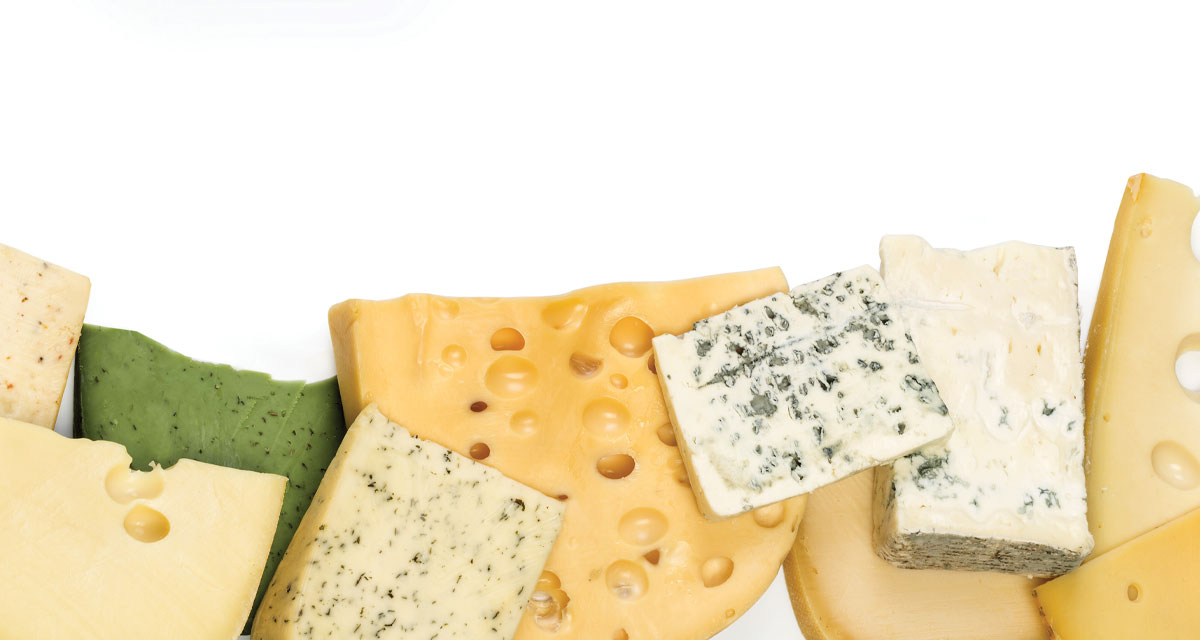Cheese, the accident of ancient days that became one of our most versatile and popular foods! Legend explains that a chemical reaction occurred after milk remained in the lining of an animal’s stomach. Enzymes then separated the liquid and created whey, while the solids developed into curds. Voila! The creation of cheese! It’s the milk that influences taste. Four thousand years ago, milk was obtained from more than just cows, sheep, and goats; buffalo, yak, and camel milk offered varying types of essential vitamins and minerals, as well. Just five quarts will produce one pound of cheese! Cheesemaking is fascinating. After the liquids drain, the curds can make cottage or Farmer’s cheese, which is a type of spread; or the solids are infused with additional ingredients to create a wheel of over one-hundred different types of cheese.
Fat is just one ingredient which gives cheese its rich texture and delicious taste. Most cheeses contain high amounts of calcium and protein and provide sources of vitamin B-12. Rather than focus on the amount of saturated fat and sodium, consider that a one-ounce slice offers a satisfying and nutrient-dense snack, or flavor to a meal. For instance, a firm cheese, such as Cheddar, Muenster, or Swiss, contains 100 calories, 180 mg of calcium, and eight grams of fat.
Who benefits from cheese?
Children, adolescents, and pregnant women would benefit from the source of calcium and added calories. The best options are cheddar, cottage cheese, goat cheese, halloumi, mozzarella, and ricotta.
Who else?
- Women threatened by osteoporosis, a weakening of the bones, should include blue and feta cheese, mozzarella, and Swiss cheese in their diets.
- Enjoy cheddar, cottage cheese, and mozzarella for gut health.
- Lactose intolerant individuals should consume cheddar, Gouda, Parmesan, and Swiss cheese.
- Eating cheese helps lower blood pressure levels!
At the end of a meal, eat a small slice of cheese! Cheddar, or another type of aged cheese, will help prevent cavities by neutralizing the mouth’s acids.
What are the most nutritious types?
- Bleu Cheese: Containing 33% of the regular daily intake of calcium, the most of any cheese variety. It is a necessary nutrient for optimal bone health.
- Cottage Cheese: A protein-enriched snack, which offers the trace element, selenium; this is a helpful mineral to reduce chronic inflammation. Cottage cheese is rich in vitamin B-12, which helps maintain the health of nerve and blood cells and boost energy levels.
- Feta Cheese: A soft yet salty, white cheese made from either sheep’s or goat’s milk. Although high in sodium, the type of animal milk provides “conjugated linoleic acid,” CLA, which aids in reducing body fat; therefore, it’s a delicious cheese to add to meals.
- Goat Cheese, Known as Chevre: The creamy, tangy flavor adds to its favorability as a spread or crumble. High in protein, calcium, and iron, the cheese is easy to digest, since it is lower in lactose than cow’s milk.
- Mozzarella: As a soft, white cheese with high moisture content, it contains fewer calories than other types, and has less sodium. Studies show its value in improving the immune system and gut health. And, as a fermented daily supplement, it fights inflammation. Need a quick snack? Start eating string cheese!
- Ricotta: Made from cow’s, goat’s, buffalo, or sheep’s milk, the whey proteins are beneficial amino acids. “Whey” promotes muscle growth, heart health, and weight management!
- Swiss Cheese: As gases release during the fermentation process, holes form to distinguish the unique Swiss cheese. If the goal is to monitor salt intake or high blood pressure, start consuming more Swiss!
- Parmesan: A calcium- and phosphorus-enriched cheese vital for bone health, lactose intolerance, and GI related symptoms.
“Say cheese!” It’s a simple command intended to promote a smile toward the photographer. The phrase, ironically, arrived in the 1940s. The “ch” combination followed by the long “ee” incites every individual to show off dimples and a wide grin, capturing happiness from those posing. A survey suggests 96% of the population favor the taste of cheese and associate it with pleasure! Let’s agree—the Victorian era could not compete with the well-established phrase. Few would produce a smile over, “Say prunes!”
Next Month: The Fact and Fallacy of Eggs























